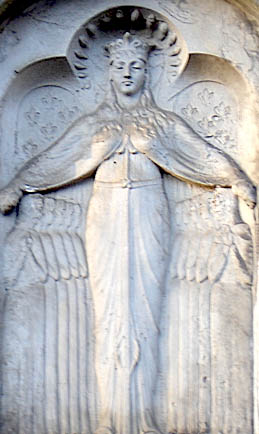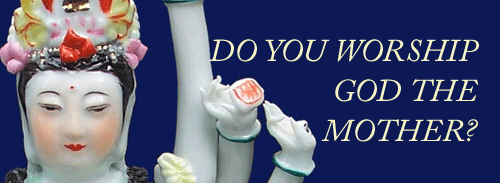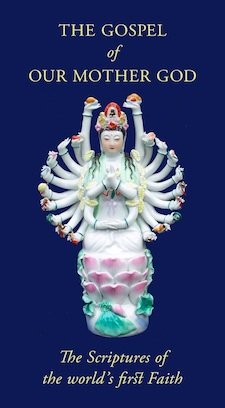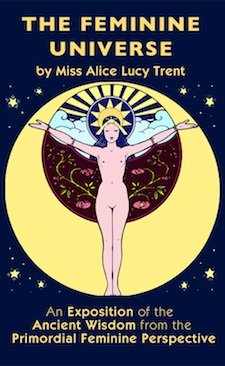The Hail Mary Prayer to Our Mother God

The words to the Hail Mary have been carefully crafted by the patriarchal Church to exclude the divinity of the Divine Mother. A very simple re-writing of the Hail Mary prayer, however, restores it to the fundamental pre-classical Western tradition of the worship of Our Mother God which was the first and universal religion of all humanity.
Here we briefly discuss the changes made in the words to the Hail Mary that restore it to the Universal Tradition of Our Mother God.
The version used here is the definitive version of the Filianic Hail Mary Prayer used in The Gospel of Our Mother God.
First the Christian version of the Hail Mary prayer:
Hail Mary, full of grace,
the Lord is with thee,
Blessed art thou among women
And blessed is the fruit of thy womb, Jesus.
Holy Mary, Mother of God,
Pray for us sinners
Now and in the hour of our death.
Here is the revised version:
Hail Mary, Fount of grace,
Lady of earth and heaven,
Blessed art Thou by all maidens
And blessed is Thy most beloved Daughter.
Holy Mary, Mother and God,
Shelter us fallen ones
Now and in the hour of our death.
Let us proceed to examine each of the revisions and see how they fit into the thealogy of Our Mother God.
Analysis of Hail Mary Prayer Revisions
Line-by-line exposition
Hail Mary, full of grace > Hail Mary, Fount of grace
"Hail Mary, full of grace" could indeed be used of Our Mother God, Mari/Marah being among the fundamental names of the original feminine Deity. However, the phrase is dangerously ambiguous.
"Hail Mary, Fount of grace" makes it clear that Our Mother God is the Source, not the recipient of Grace. She is full of Grace in a sense that no created being can be because She is the Source and Fount of all Grace.
The Lord is with thee > Lady of earth and heaven
One of the more radical revisions, necessary for obvious reasons. Some revised versions use the phonically more similar "all Godhead is Thee" and this revision is discussed at length on this page on Feminine Trinity and the Hail Mary prayer
In this definitive version, as used in The Gospel of Our Mother God the assonance with the Christian version has been abandoned in favor of a simple and universal statement of Déanic faith.
Blessed art thou among women > Blessed art Thou by all maidens
The Christian version implies, and is intended to imply, that Mary was a "woman" who became blessed by the masculine god. There is a certain ambiguity and "blessed art thou among women" could mean that women give blessing to Dea. However, this revision removes the ambiguity.
"Blessed art Thou by all women" could also be used; however, the version published in The Gospel of Our Mother God is intended for use by all devotees including Chelouranyi, who avoid the term "women".
And blessed is the fruit of thy womb, Jesus > And blessed is Thy most beloved Daughter
The reference to Jesus was actually inserted into the Hail Mary prayer after it had been in use for some centuries. The purpose of this was precisely to try to inhibit the worship of Mary as Our Mother God.
It is possible to leave out this line entirely, which is only taking the Hail Mary prayer back to an earlier form, but since many devotees of Our Mother God are Filianist Trinitarians this adaptation is the one most commonly used.
Another important aspect of this emendation is the removal of the "womb" reference. The birth of God the Daughter is not a human incarnation but coming of the Universal Savior. It is not a material human birth but a transcendent Divine birth.
Holy Mary, Mother of God > Holy Mary, Mother and God
A simple and obvious emendation. The formula "Mother of God" in Christian usage has always been heavy with ambiguity. It clearly implies a Being antecedent to, and the Source of, the masculine deity. Christians are then left with the task of denying what they have so strongly implied. "Mother of Jesus" would not imply this, but words have a power of their own, and the much more ambiguous phrase "Mother of God" has always been used.
However, pure worshippers of Our Mother God do not recognize any God but She. As it says in the Filianic Creed:
I believe that Dea is One, and there is none beside Her.
Thus in the Déanic versions of the Hail Mary prayer, "Mother and God" places the matter beyond all doubt and ambiguity.

Pray for us sinners > Shelter us fallen ones
Since Mary is God, to whom would She pray?
The Daughter prays to the Mother in The Gospel of Our Mother God, but Mary is the Name of the Mother Herself. We come to Her not for prayers to some other god, but for shelter beneath Her mantle.
There is also a subtler thealogical issue here: the implication of "praying for" sinners could be that of interceding for them with an angry masculinized "god".
The Déanic version of the Hail Mary prayer makes it clearer that we are calling on the all-powerful and all-loving Mother to shelter us from the "ungentle winds of werde" – the sorrows and dangers of the samsara.
The last line is identical in each version.
Whichever version of the Hail Mary prayer you choose, we wish you all joy and blessings in Our Most Beloved Lady.
Why not read your Bible: The Gospel of Our Mother God?
Further Reading on the Hail Mary Prayer
Lecture on the Hail Mary of Our Mother God: MP3
Questions on the Feminine Trinity and the Hail Mary
See also:
The Immaculate Heart of Mary: A beautiful and profound symbol of Our Dear Lady's Godhead
Creation Myths and the Virgin Mary: What is a Creation Myth? Is it true? And how is Our Lady Mary connected with the primordial Creation Myth?
Choosing a Virgin Mary Statue: A guide for devotees of Our Mother God
Mary Statues as Images of God the Mother: Further important information on statues of the Blessed Virgin Mary
Maria-sama no Kokoro: A beautiful online video of a hymn to the Immaculate Heart of Mary, with Déanic interpretation
Mary and Eve: Reflections on the original Divine status of Eve as Creatrix and the traditional idea of Mary as "the New Eve"
Please support the Chapel of Our Mother God
Send Questions or Comments on the Hail Mary Prayer
Chapel of Our Mother God Homepage
All written material at the Chapel of Our Mother God is copyright. Should you wish to reproduce any portion please contact us for permission.
Facebook or Twitter
This section:
Devotional Practices
Shrines
- Shrines to Dea
- Virtual Shrine
- How to Make a Shrine
- Living Goddess Images
- Choosing a Virgin Mary Statue
- Mary Statues as Images of God
- Maria-sama no Kokoro
- Hail to the Princess: A Nativity Carol
- An Easter Hymn
- Maria Mantra: a Universal Invocation
- Inanna Lalitha Devotional Chant
- The Marianna Maria Chant
- The Great Compassion Mantra
- How to Pray the Rosary
- Rosary Prayers
- Rosary Meditations
- Nativity Rosary Meditations
- Mala Beads: The Chanting Rosary
- The Rosary of the East
Gospel of Our Mother God
The Gospel of Our Mother God is a collection of inspirational texts, prayers and daily inspiration for the Mother-Faith devotee or household.
The Feminine Universe
The Other Philosophy
Everything you have ever heard comes out of the patriarchal world-view. Its materialism, its religion, even its feminism. Here is the other way of seeing the world; the natural way: the way that everyone saw things before patriarchy and will again when patriarchy is long forgotten.


